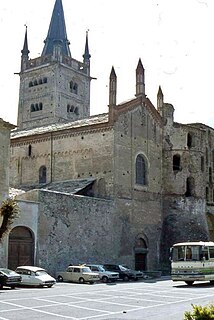
Adria is a town and comune in the province of Rovigo in the Veneto region of northern Italy, situated between the mouths of the rivers Adige and Po. The remains of the Etruscan city of Atria or Hatria are to be found below the modern city, three to four metres below the current level. Adria and Spina were the Etruscan ports and depots for Felsina. Adria may have given its name during an early period to the Adriatic Sea, to which it was connected by channels.

Rovigo is a town and comune in the Veneto region of Northeast Italy, the capital of the eponymous province.

The Province of Rovigo is a province in the Veneto region of Italy. Its capital is the city of Rovigo. It borders on the north with the provinces of Verona, Padua and Venice, on the south with the province of Ferrara, on the west with the province of Mantua, and on the east with the Adriatic Sea.

Polesine is a geographic and historic area in the north-east of Italy whose limits varied through centuries; it had also been known as Polesine of Rovigo for some time.

Alberto Azzo II, Margrave of Milan, and Liguria, Count of Gavello, Padua, Rovigo, Lunigiana, Monselice, and Montagnana, was a powerful nobleman in the Holy Roman Empire. He is considered the founder of Casa d'Este, having been head of the first family to be master of Este, a town of Padua.
The War of Ferrara was fought in 1482–1484 between Ercole I d'Este, duke of Ferrara, and the Papal forces mustered by Ercole's personal nemesis, Pope Sixtus IV and his Venetian allies. Hostilities ended with the Treaty of Bagnolo, signed on 7 August 1484.

The Italian Catholic Diocese of Adria-Rovigo, in the Triveneto, has existed under this name since 1986. It is a Latin suffragan to the Patriarchate of Venice.

Lendinara is a town and comune in the province of Rovigo, Veneto, northern Italy. It is part of the historical and geographical region of Polesine.

Badia Polesine is a comune (municipality) in the Province of Rovigo in the Italian region Veneto, located about 70 kilometres southwest of Venice and about 25 kilometres west of Rovigo. It is part of the upper Polesine, and is bounded by the Adige river, which separates the communal territory from the province of Padua.

San Bellino is a comune (municipality) in the Province of Rovigo in the Italian region Veneto, located about 73 kilometres (45 mi) southwest of Venice and about 15 kilometres (9 mi) west of Rovigo.

The Abbey of San Giovanni in Venere is a monastery complex in the comune of Fossacesia, in Abruzzo, central Italy. it is located on a hill facing the Adriatic Sea, at 107 m over the sea level.

The so-called breach at Cucca traditionally refers to a flood in the Veneto region of Italy that should have happened on October 17, 589 according to the chronicles of Paul the Deacon. The Adige river overflowed after a "deluge of water that is believed not to have happened after the time of Noah"; the flood caused great loss of lives, and destroyed part of the city walls of Verona as well as paths, roads and large part of the country in lower Veneto.

The Diocese of Vittorio Veneto is a Roman Catholic diocese in northern Italy, with capital in Vittorio Veneto. It was historically known as Diocese of Ceneda, the name being changed in 1939.

Blessed Beatrice d'Este was the daughter of Azzo VI of the Este family by his second wife, Sophia Eleanor, daughter of Humbert III, Count of Savoy. She was the aunt of Saint Beatrice d'Este.

The Roman Catholic Diocese of Susa, in Piedmont (Italy), was established in 1772. It is a suffragan of the archdiocese of Turin. The diocese and the city of Susa lie on the main route that leads to Italy from the Mont Cenis Pass and the Col de Montgenèvre.

Adria Cathedral is a Roman Catholic cathedral in the city of Adria, in the province of Rovigo and the region of Veneto, Italy. Formerly the episcopal seat of the Diocese of Adria, it has been since 1986 that of the Diocese of Adria-Rovigo.

The Cathedral of Sansepolcro is a Catholic church in Sansepolcro, Tuscany, central Italy.
Santa Maria della Carità is a Renaissance-style Roman Catholic church in central Bologna, Italy.

The church of San Secondo di Magnano is built in a wide open space near the Serra d'Ivrea, not far from the Bose monastic community, in the comune (municipality) of Magnano, Italy. It is one of the most interesting examples of the Romanesque architecture in the Provincia di Biella and the Canavese.

Brugnato Cathedral is a Roman Catholic cathedral located in the old centre of the city of Brugnato, in the Val di Vara in the province of La Spezia, Italy. The dedication is to Saint Peter, Saint Laurence and Saint Columbanus. Once the seat of the bishops of Brugnato, it is now a co-cathedral in the Diocese of La Spezia-Sarzana-Brugnato.


















